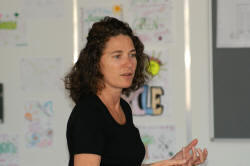Types of verbs and clause structures

This is an overview. For more detail
on any of this, follow the links in the table at the
end.
Verb types in English are complicated. In her book,
English Verb Classes and Alternations: A Preliminary
Investigation, Beth Levin considers some 3000 English
verbs and classifies them in a bewilderingly complex way,
identifying over 80 types based on their functions in
sentences. Note, too, that this is subtitled A
Preliminary Investigation.
This is a site for language teachers, not theoretical
linguists, so the following will not be quite so
comprehensive. In fact, we'll focus on just six types
to begin with and then we'll look at some alternative
classifications.
This guide considers lexical or main verbs only. There is a
separate
guide to
primary auxiliary verbs and
modal auxiliary verbs
get a whole section to themselves (both links open in a new tab).
So, what is considered below are verbs which are not:
- acting to form a tense, voice structure or aspect (the role of primary auxiliary verbs),
for example:
John was reading
She has finished
I got the house painted
They have been arrested - signalling the speaker's view of an event or state is in
terms of its likelihood, necessity, ability, desirability etc. (the role of modal
auxiliary verbs), for example:
She dared to complain
They should be here soon
We must go
I wouldn't be able to help
This guide is quite long so here is a menu of its contents to use if you are looking for something in particular.
At the end of each section, you can click on -top- to return to this menu, simply read on, scroll back or bookmark the page for another time.
 |
Website warning and types of analysis |
If you put something like verb types into a search
engine, you will be confronted with a confusing variety of sites
which claim to know what verb types there are. Some will
define three types, some four, some five and so on up to 12.
Within those classifications we will find modal auxiliary verbs,
primary auxiliary verbs and lexical or main verbs of one type or another
mixed with promiscuous carelessness. That way, madness lies.
This guide, as we said, is not concerned with all verb types and
excludes auxiliary verbs of either type. It is also not
concerned with gross levels of analysis which distinguish between
transitive and intransitive verbs and leave it at that.
What we are concerned with here is how we can classify verbs by
their grammatical functions and their structural characteristics and
that means avoiding crude descriptions such as action verbs and so
on.
An alternative analysis, to which there is a guide on this site, linked at the end, is to classify verbs into what processes they encode. Briefly, that will include
- Material and behavioural processes:
- The house collapsed
- John left
- Thinking and saying processes:
- She believed his story
- He said he was driving
- Existential and relational processes:
- There used to be a garden here
- His office is on the top floor
That is a perfectly legitimate, some might say, superior analysis
of verb types and considering the processes that verbs encode
explains a good deal about traditional categories concerning
transitivity and dynamic or stative uses.
It is not the approach taken here because this guide is mostly concerned
with the grammatical rather than semantic characteristics of verbs.
Meaning, however, plays an important part in the alternative
structures that are available.
 |
6 types of verb |
There are, by some estimates, over 25,000 verbs in English (not
including derivatives) so we need a way to make sense of the data.
This guide does not lay claim to what follows being the only way.
Here are six examples of verbs performing various functions in English.
- The police officer became angry.
- She is a doctor.
- They gave the man some money.
- I cooked the dinner competently.
- Peter arrived late at the party.
- They elected her president.
These six types have been chosen because distinguishing between them is one of the most difficult things for learners of English to do. Partly, this is because languages vary a lot in how verbs can be characterised and what they do.
 |
Subjects and predicates |
The six examples above represent six of the most common clause forms in English. We can analyse them like this:
- In each there is a simple subject
- Sentence 1.: The police officer
- Sentence 2.: She
- Sentence 3.: They
- Sentence 4.: I
- Sentence 5.: Peter
- Sentence 6.: They
- The subjects are followed by what is usually called the predicate (i.e., the rest of the sentence including the verb which drives the meaning). In functional grammar, these two parts would be called the theme (the subject) and the rheme (the predicate).
However, the predicates are more complicated. There are six
different sorts. Here are the example sentences again with the
predicates in red.
Your task, should you accept it, is to identify what makes up
the predicates (type of verb, word class, types of phrase etc.)
When you have done that,
click here.
- The police officer became angry.
- She is a doctor.
- They gave the man some money.
- I cooked the dinner competently.
- Peter arrived late at the party.
- They elected her president.
- In The police officer became angry
- we have what is called a subject
complement. The word angry is not the object of
the verb because
it can't work as a noun. What it does is to tell us more
about the subject of the sentence with the adjective angry. The verb here is called
a copular verb to which there is a guide on this site linked in the list of related guides at the end.
The structure of this sentence is
Subject–Verb–Subject Complement or SVCS. - In She is a doctor
- we have another copular verb (be)
but this time followed by a noun. However, the noun a
doctor is still
not
the object of the verb because a doctor and she
represent the same entity. The two are, in the jargon,
co-referential. Again, it's a subject
complement.
The structure of this sentence is also
Subject–Verb–Subject Complement or SVCS. - In They gave the man some money
- we have two proper objects: the man and some
money. The roles of these objects are different,
however:
some money is the direct object because that is what they gave (it is what was affected by the action of the verb).
the man is the indirect object because he is the recipient of the action.
The structure of this sentence is
Subject–Verb–Indirect Object–Direct Object or SVOIOD.
In English, indirect objects come before direct objects. In many languages, it's the other way around.
A simple test for the difference is to leave one of the objects out:
They gave some money
makes sense so
some money
is the direct object.
They gave the man
makes no sense so
the man
is the indirect object.
English can reverse the order of the two objects by using a prepositional to-phrase or for-phrase as in, for example:
They gave some money to the man
She bought dinner for everyone
In this case, we have the simpler clause structure of
Subject–Verb–Direct Object–Adverbial or SVODA
as in the next example. - In I cooked the dinner competently
- we have only one object, the dinner, and if there
is only one object, it is the direct object. This sentence
also contains an adverbial (the adverb competently).
The structure of this sentence is
Subject–Verb–Direct Object–Adverbial or SVODA
The position of the adverbial is not fixed in English so we allow:
I competently cooked the dinner
Other elements are much more stable.
Leave out the adverbial and we have the simpler SVOD sentence. - In Peter arrived late at the party
- we have no object at all. This is
because arrive is an intransitive verb (in English) and
can take no object. In this sentence, there are two
adverbials:
The temporal adverbial late which is an adverb.
The locative adverbial at the party which is a prepositional phrase.
The structure of this sentence is
Subject–Verb–Adverbial–Adverbial or SVA
(only one 'A' because we can keep adding adverbials ad infinitum).
It is possible, of course, to omit the adverbial and the we get a simpler structure
Subject–Verb or SV
as in, e.g.
He works
They complained
It snowed
etc. - In They elected her president
- we have a slightly less common sentence
structure in that we are using an object complement
rather than the subject complements we saw in examples 1 and 2.
In this sentence her is the direct object and the noun
president is its complement telling us about the object in the
same way that angry and a doctor tell us about
the subject in example sentences 1 and 2.
It is also possible (and more common) to use an adjective as the object complement in a clause such as
They made her angry.
The structure of these sentences is
Subject–Verb–Object–Object Complement or SVOCO
It's important that you are sure about these clause structures so try this short matching test before we go on.
 |
Six things to notice |
- Nominalised object clauses
Direct objects of verbs can also be clauses acting as nouns, introduced with that, which is why they are called nominalised that-clauses. For example:
He told me a lie
has the direct object a lie and the indirect object me but:
He told me that he was hungry
Has the structure
Subject–Verb–Indirect Object–Direct Object
but here the Direct object is the nominalised clause that he was hungry.
Nominalised that-clauses cannot act as indirect objects. Indirect objects are mainly noun clauses or pronouns, never that-clauses.
Nominalised that-clauses cannot be moved as indirect noun-phrase or pronoun objects can, so, while we allow:
He told a lie to me
we do not allow:
*He told that he was hungry to me - Object complements
There is a variant of the
Subject–Verb–Direct Object–Adverbial
structure which deploys a complement (usually an adjective or a non-finite verb form). For example:
He kept the people happy
She left her mother wondering what happened
We could make this the seventh structure but in fact, it follows the structure of the final category above. It is, functionally
Subject–Verb–Object–Object Complement or SVOCO - Optional and obligatory adverbial complements
Adverbial complements are usually considered optional elements of sentences so we can have:
I made the beds
which is
Subject–Verb–Direct Objector SVOD
and
I made the beds immediately
which is
Subject–Verb–Direct Object–Adverbial or SVODA
However, a few transitive verbs (notably, put, place, stand and treat) insist on an adverbial complement so while we can have
I put it down
He treated her badly
I placed the table in the corner
I stood the lamp over there
we do not allow simply SVOD, in these meanings of the verbs:
*I put it
*He treated her (except in a medical sense)
*I placed the table
*I stood the lamp
The normally intransitive verbs lie and live (the latter in the sense of abide rather than exist) also demand an adverbial complement so do not allow the pattern of simple Subject–Verb or SV as most intransitive verbs do. So, for example, we can accept
He lay on the bed
or
She lived in London
but not:
*He lay
or
*She lived (except in the meaning of survived)
What this all means is that some verbs require adverbials which are not adjuncts, for adjuncts may be omitted, but these compulsory adverbials may not.
There is a little more on this in the guide to adverbials, linked below, under the heading of PP complement verbs. - Ellipsis of the object or conversion
Some transitive verbs which would normally demand the structure
Subject–Verb–Direct Object–Adverbial or SVODA
allow us to suppress or make implicit the object and can appear in
Subject–Verb–Adverbial or SVA
structures (or simply SV, of course):
She's reading at the moment
implies an object, as does
They are smoking outside
They washed before lunch
She drank quickly
etc.
In other words, the SVODA exists by implication but not in the overt structure of the sentence. In the example above the implied objects are:
a text of some sort
cigarettes, pipes or cigars
their hands
some liquid
Many other transitive verbs do not allow this object ellipsis so we do not permit:
*He used
*They made
*The children liked
etc.
There are two views of this:- That the object is implicit and suppressed so, e.g.:
He is eating
implies an object (some kind of food). - That the verb has been converted from a transitive to an
intransitive version so, e.g.:
He is eating breakfast
is SVOD
but
He is eating
is SV
- That the object is implicit and suppressed so, e.g.:
- Postponement of the object
Slightly unusually, the normal word ordering of either SVODA or SVOCO can be disturbed when we wish to lay some emphasis on the direct object of the verb. We can change, therefore, e.g.:
She made all the people at the meeting uneasy
which follows the usual SVOCO ordering to
She made uneasy all the people at the meeting
in which the complement splits the subject and the direct object.
We see this, too, in, for example:
They explained how to fix the problem to the engineers
which is the normal SVODA ordering changing to:
They explained to the engineers how to fix the problem
in which the adverbial splits the verb from its object.
What is happening here is that the direct object of the verb is postpositioned because the speaker / writer wishes to mark it in some way and the conventional way to do that (or one of them) in English is to transpose the phrase or clause to the end of the sentence, giving it end focus and end weight. - Split phrases
The usual ordering of the elements of a clause can also be disturbed (and more difficult for people to follow) if a noun phrase is split from its modification by the adverbial(s). We may have therefore, instead of the usual:
We delayed the discussion of the new policy until the end of the meeting
which has the usual ordering of SVODA, we can encounter:
We delayed until the end of the meeting the discussion of the new policy
in which the modifier of the noun phrase is split from the noun by the adverbials.
We may also meet with:
Everyone came to the party except the Smiths
in which the subject noun phrase is everyone except the Smiths but it has been split by the verb phrase and the adverbial with the modifier of everyone (except the Smiths) postpositioned for emphasis.
This also occurs frequently with comparative clauses and phrases so we get, for example:
More people have come to the party than we expected
in which the subject noun phrase (more people than we expected) is split by the verb phrase and the adverbial.
It can, naturally, be rephrased as
More people than we expected have come to the party
in which the structure (SVA) is somewhat clearer.
The last two of the points above (5. and 6.) refer to unusual or slightly unexpected ordering of the elements but the elements themselves are unchanged. However, any splitting or unusual positioning of phrases in clauses make the meaning less easy for non-native speakers to infer.
 |
But all that is about clause structures.
|
OK, and so it is. Bear with us.
A moment's consideration will reveal that verbs can be classified
according to the types of clauses they appear in. In fact,
certain classes of verbs require certain clause
structures.
In the following some abbreviations have been used, as they have
above. Here they are explained:
| Code | Expands to ... | Example |
| S | Subject noun phrase | Mary and her sister
came home Mary and her sister is the subject |
| V | Verb phrase | They
put her
up for the night put up is the verb phrase with the object embedded |
| CS | Subject complement | John is
a doctor a doctor is the subject complement co-referential with the subject, John. It is not the object of the verb because it is the same as the subject. |
| CO | Object complement | They made her
happy the object complement is happy because it applies to her, the object of the verb make. |
| A | Adverbial phrase | She
suddenly
disappeared the adverbial is suddenly. Even though the adverbial comes before the verb, a sentence of this sort can be described as SVA because the adverbials can often follow the verb (She disappeared suddenly last night) |
| O | Object noun phrase | If only one object is present, we
can use O to denote it. In He broke the window, the object is the window. When there is a possibility of two objects being present (even though one may not be) we use the following. |
| OD | Direct object | He paid
the money the direct object is the money. |
| OI | Indirect object | He paid
her the
money the indirect object is her. |
Now we have the mechanics of how clauses work, we can identify which kinds of verbs work with which kinds of clauses.
 |
Intensive verbs |
| She seems happy |
Intensive verbs take subject complements rather than objects and appear in clause structure SVCS. For example:
- I am a nurse
- Peter is running to fat
- She is getting aggressive
- He is growing old
- He seemed even more delighted
- John fell ill
- She turned aggressive
When they are used as copular verbs they cannot be used
dynamically:
*They are being doctors
*He was appearing happy
etc. Examples 1, 5, 6 and 7 are copular verbs taking the SVCS
structure.
When such verbs are used
dynamically, the sense is usually a change of state rather than a
consistent attribute of the subject. Examples of the SVCS
structures with these verbs used dynamically are 2, (a change of
state from thin to fat), 3, (a change of state from
peaceable to
aggressive) and 4. (a change of state from younger to
older).
You can see that the example
She turned
aggressive
is copular rather than dynamic use because it represents
the end point of the change of state, not the process.
Similarly,
He fell ill
is a
copular use for the same reason but
He
is falling ill
is a dynamic use describing the change of
state. Both uses differ from the more common intransitive use
of the verb as in:
He fell over
Although not a term with which to trouble your learners, verbs referring to changes in state are often called
inchoative or
inceptive.
Intensive verbs do not take objects – they take complements.
In the sentences above we have the following types of complement:
- a nurse (a noun complement co-referential with the subject)
- to fat (an adverbial complement, in this case a prepositional phrase)
- aggressive (an adjective subject complement)
- old (an adjective subject complement)
- even more delighted (an adjective phrase subject complement)
- aggressive (an adjective subject complement)
 |
Extensive verbs |
| It extended for miles |
Extensive verbs form all the other sorts of clause structures we have
looked at. They are intransitive, monotransitive or
ditransitive and they appear in different clause structures.
(If you aren't fully sure about these terms, check out
the guide to subjects and objects (new tab)).
 |
Intransitive |
| He waited |
Intransitive verbs include, e.g., appear,
arrive,
come,
disappear, rain, snow, work etc. Obviously, they can
have no truck with any clause structure which contains an object.
Think about what sorts of clauses they
can form
and then click here.
- SV:
- Subject–Verb
She has been waiting
They arrived
It snowed - SVA:
- Subject–Verb–Adverbial
They disappeared completely
He suddenly appeared
He has definitely died
Some verbs can be transitive and intransitive (sometimes with a
change in meaning). For example:
She ate at one o'clock
is intransitive and SVA, but
She ate lunch at one
o'clock
is transitive and SVODA
He worked in the same office
is intransitive and SVA, but
He worked a miracle for us
is transitive and SVODA
An alternative way to analyse this is to suggest that the object in
the first example has been ellipted but is implied (see Note 4 above).
An example of a verb which changes meaning when used in the two ways
is:
I can manage on $50 a week
(intransitive and SVA)
vs.
She manages two shops
(transitive and SVO)
When they are transitive, these sorts of verbs follow one of the patterns
below.
See also Note 3, above concerning the verbs lie
and live which insist on the inclusion of an adverbial and
cannot be merely SV. More on this below.
 |
Monotransitive only |
| They shared an umbrella |
Monotransitive verbs include, e.g., attend,
believe,
describe,
enjoy, find, join, share, take, use, watch etc.
What kinds of clauses do they demand?
Click here when you have an answer.
- SVOD
- Subject–Verb–Direct object
They attended the meeting
He believed the story
We enjoyed the dinner
I watched the film - SVODA
- Subject–Verb–Direct Object–Adverbial
He described the view to her
I found the car easily
I joined the party rather late
I used the hammer too much - SVOCO
- Subject–Verb–Object–Object complement
There is a small group of monotransitive verbs which take object complements which includes many of opinion (such as consider, find, believe etc.) and others which denote causing a change in something (such as paint, make, sweep, name, declare, call etc.). In all cases, the complement refers to the object of the verb.
In some analyses, these are called factitive verbs.
A list of such verbs includes: announce, appoint, assess, assign, believe, call, choose, consider, declare, deem, designate, dye, elect, find, imagine, judge, keep, label, make, name, nominate, opt for, paint, proclaim, pronounce, prove, select, sweep, think and a few other close synonyms.
Examples are:He announced it finished
They appointed her their representative
She assessed Mary the best
She believed me mistaken
I called him a genius
As a co-worker, she chose John
They consider me a fool
The referee declared her the winnerI deemed it important
They designated John chairman
We dyed it blue
The people elected him president
I found it inedible
They judged her the best person for the job
I labelled it poison
He made me angryI named the cat 'Nicotine'
They nominated her to answer the question
I proclaimed her the winner
I painted the door green
They pronounced the job well done
They proclaimed him emperor
We thought her foolish
I swept the room cleanFactitive verbs usually signal that their object has been changed in some way. This can be that it is put into a certain category or that its condition has changed and in this sense the verbs are causative in nature. They differ, however, from causative verbs properly defined and that is made clear in the guide to the causative, linked below.
Most transitive verbs do not allow the ellipsis of the object
(see Note 4 above).
Some transitive verbs allow the use of a nominalised that-clause
as the direct object. None allows that-clauses as indirect
objects (see Note 1 above).
There is a class of verbs, sometimes called PP complement verbs, which
require complementation with an
adverbial. The adverbial in this case is not an adjunct
because it cannot be omitted and leave a well-formed sentence.
These verbs usually refer to placing something somewhere and are,
necessarily, nearly always transitive and follow the SVODA
format with the difference that A is obligatorily
present.
The verbs include at least:
keep, lay, place, plonk, position, put,
rest, set, site, situate, stick, stuff
For example, we cannot have:
*John laid the book
*I placed the vase
*I stuck the suitcase
and so on although, of course, the verbs can be used in other
senses without the adverbial.
For more, see the guide to adverbials, linked below.
The verbs stay and venture are intransitive but can be included when
the former means live
temporarily and the latter means move oneself into danger, so
I stayed in a hotel
is possible but, in the same sense of the verb,
*I stayed
is not.
We ventured into the castle
is acceptable, but in the same sense of the verb
*We ventured
is not.
These two verbs, therefore, follow the SVA patterns when used in
these senses.
There is an argument that many so-called prepositional verbs such as
account,
acquaint,
adhere,
allude,
amount,
conceive [as in imagine],
consist,
count, long,
rely and vouch also fall into the category because
they are intransitive in use but require a prepositional phrase
complement.
They are often categorised as verbs with dependent prepositions and
may be considered transitive if taken with the preposition or
intransitive and followed by a compulsory complement.
For more, see the guide to multi-word verbs, linked below.
A further class of monotransitive verbs are called reflexive verbs (see below).
 |
Ditransitive |
| She asked the man a question |
Ditransitive verbs include, e.g., ask, bring, find, give, offer, pay, save, teach etc. What clause structures do ditransitive verbs demand? Click here when you have an answer.
- SVOIOD
- Subject–Verb–Indirect object–Direct object
He asked me a question
They offered me a drink
They saved me the trouble
I found him the money
I offered her the job
It taught me a good lesson
These can also
carry adverbials just like any other verb phrase as in:
I gave her the
book yesterday evening after dinner
which is SVOIODA
When
these are verbs are used monotransitively, they can function as those listed above under monotransitive verbs.
For example:
They asked a question (SVOD)
They offered the apology too late (SVODA)
I saved the money (SVOD)
I found him irritating (SVOCO)
etc.
By their semantic nature, most
indirect objects are animate or represent a corporate body so we
get, for example:
He left the charity his money
She gave her mother some flowers
etc.
That is not a universal rule because we can also have:
I gave the house a good clean
I gave it a thump with a hammer and it started working again
I found the car a servicing agent
etc.
 |
The dative shift or alternation |
An alternative ordering is to introduce the indirect object with either to or for. This phenomenon is called a dative shift or sometimes dative alternation, dative being the case in those languages for which this matters used to signal the indirect object.
- to + the indirect object
- suggests the object is affected by the action so, for
example:
She sent her father the money
shifts to:
She sent the money to her father
and
I threw her the ball
shifts to:
I threw the ball to her - for + the indirect object
- suggests that the object is the beneficiary of the action
so, for example:
She baked me a cake
shifts to:
She baked a cake for me
and
She saved me a bit
shifts to:
he saved a bit for me
Occasionally, a verb may take either to or for
depending on its meaning so we allow both:
She taught the class for me (i.e.,
instead of me)
She taught chemistry to me
(i.e., instructed)
and
They left the money for me (i.e.,
allowed to remain)
His father left the money to him (i.e.,
bequeathed)
and
He paid the money to her (i.e., gave)
He paid the money for her (i.e., instead of her)
The verb ask is also slightly irregular because it can
be formed using of in the dative shift with:
I asked the man a question
shifting to:
I asked a question of the man.
A few verbs for stylistic reasons will only appear with or
without this dative shift. This is a purely idiomatic effect
with no rule to follow so we allow, e.g.:
She introduced me to the teacher
but not
*She introduced the teacher me
and
Give me a break
but not
*Give a break to me
and
They bet me five dollars
not
*They bet five dollars to me
Other verbs which cannot be used with the to or for
dative shift are:
allow, call, charge, consider, cost, fine, name, permit, refuse,
spare and wish.
So, while we allow, for example:
He allowed the audience three questions
They cost us too much money
She spared me some time
etc., we do not allow:
*He allowed three questions to / for the audience
*They charged $400 to / for him
*They wished Happy Christmas to / for me
 |
Target or beneficiary? |
The distinction between the use of to or for as the choice in the prepositional phrase is mostly a semantic issue:
- If the object is the target of the verb,
to is preferred so we get, e.g.:
They brought the food to us
She paid to money to him
He read a story to the children
They gave the money to their lawyer - If the object is the beneficiary of the
verb, for is preferred so we get, e.g.:
He bought the car for her
I cooked a meal for them
He wrote an essay for him
The tailor made a coat for her
Some verbs which signify that the indirect object is the
beneficiary can only be used with for + the indirect object
dative shift and they include:
allocate, bake, build, buy, catch, cause, cook, construct, cut,
design, dig, draw, earn find, get, make, order, pour, prepare,
print, save, set, wash and win. So, while we
allow, for example:
They allocated some seats for us
They caused some trouble for us
She designed a house for me
They ordered lunch for us
and so on, we cannot have:
*They built a house to me
*She poured a drink to me
*He printed the letter to me
*The hotel washed a shirt to me
etc.
Other ditransitive verbs are slightly more forgiving but one
form is often strongly preferred. For example:
They asked her a question
not usually
They asked a question to her
and
I owed her the money
not usually
I owed the money to her
If the less preferred option is the dative shift, it is often a
case of marking the indirect object for emphasis.
We saw above that the dative shift cannot be used when the direct
object is a nominalised that-clause and the same applies to
nominalised wh-clauses so we allow:
She told him that she would be late
but not
*She told that she would be late to him
and we allow:
She taught the class what they needed
but not
*She taught what they needed to the class
The dative shift or alternation is often the preferred way of
marking the rheme of the sentence in a way that makes it the natural
theme of the following clause so, for example:
She read the children a story ...
is naturally followed by:
... which they loved
but
She a read a story to the children ...
is more naturally followed by:
... and they went to sleep happily.
A list of ditransitive verbs with the to / for distinction noted, along with the uncommon ones that can take neither structure, is available via a link in the related guides list at the end.
 |
Omitting an object |
Generally speaking, only the indirect object may be omitted in a
ditransitive structure so, for example:
She read the children a story
and
She read a story
are both permissible but
*She read the children
makes no sense.
This applies to the majority of ditransitive verbs. Normally, in fact, a
defining characteristic of the indirect object is that it can be
omitted but omitting the direct object leaves a malformed clause.
However, there is a notable complication here:
All the following are, therefore, allowed:
| We asked
her a question We asked her We asked a question |
I owed
John $10 I owed John I owed $10 |
They
paid me the money They paid me They paid the money |
I promised
the man the money I promised the man I promised the money |
She showed
the meeting the
figures She showed the meeting She showed the figures |
He taught
my son history He taught my son He taught history |
Mary
told her a lie Mary told her Mary told a lie |
 |
Reciprocal and reflexive verbs |
| They were talking |
A distinction sometimes made between verbs is whether the word is
functioning reciprocally or not.
For example, these are non-reciprocal uses:
Mary was talking to us
John and Peter fought in the war
Mary and Ann shouted at me
and reciprocally, they may be expressed as:
Mary and we were talking
John and Peter were fighting over a toy
Mary and Ann shouted at each other
When used reciprocally, such verbs often take a reciprocal pronoun
as their objects, each other, one another etc. or an
adverbial, together, with each other etc.
Reflexive verbs, on the other hand, are those in which the
subject and the object are the same. For example:
She was washing
The dog was scratching
in which, because the object is omitted, we assume it to be herself
and itself respectively.
English makes little use of reflexive verbs. They occur, for
example, in:
She asked herself a question
He poured himself a drink
and so on.
In other languages, however, reflexive verbs are very extensively
used and will include verbs such as: apologise, brag, call,
change, complain, decide, hide, lie, prepare, shower, (un)dress,
sit, swim, talk, worry and hundreds more.
Reflexive verb use in English is often signalled by the use of a
reflexive pronoun if any ambiguity is to be avoided:
She was talking to herself
The dog was scratching itself
The rule: A potentially transitive verb used with no object will normally be understood to be operating reciprocally or reflexively.
 |
Parsing the clauses |
| tree diagrams |
For classroom presentation purposes,
and to get the structures clear in your own head, parsing the
clauses is a visual way of understanding the structures we have
considered.
Here's a set of examples of all six clause structures:
 |
 |
 |
 |
 |
 |
Adverbials are not shown in all cases but can be inserted so we can get, e.g.:
He is old now
She called me stupid immediately
I liked the film a lot last night
She read the children a story this morning after they woke up

In theory, at least, mastery of all the clause types allows one to handle most of the language, at least as far as clause structures are concerned.
 |
Verbs which can have more than one nature |
English is far laxer than many languages in allowing verbs to be
used with and without an object. The phenomenon is known as
ambitransitivity and applies to a range of verbs.
In other languages, when such verbs are used with an object, they
are often made reflexive so, for example, in English we can allow:
I washed
and
I washed the car
as well as
I broke the cup
and
The cup broke
In other languages, such as most Romance languages, that is not
possible and the form without an object will translate as:
I washed myself
and
The cup broke itself
Many common verbs, such as break, drive, finish, manage, smoke, turn
and write etc., are two-faced in this way and can be transitive or intransitive.
There are three sorts of these:
- Those in which the meaning remains whether transitive or
intransitive.
For example:
He only smokes in the garden
He smokes a pipe
I drove for hours
I drove my father's car
I flew to Nice
I flew the helicopter
I ate at 6
I ate dinner at 6
The verb call is slightly anomalous because intransitively it means visit or telephone and transitively it only means telephone:
I called at 5 but you were out
I called at six but you didn't answer
I called him repeatedly but he didn't answer
The verb also has a transitive-only use with an object complement meaning name:
We called the cat George - Those in which there is a variably substantial difference in
meaning depending on how they are used.
For example:
I shone the light on the desk
The sun shone brightly
The child grew quickly
It grew dark
I grow potatoes on my allotment
She left early
She left the keys on the table
I walked to London
I walked the dog
(There is another pseudo-transitive use of the verb walk as in, e.g.:
We walked six miles
We walked a good hour
but these are better seen as reduced prepositional phrases for for six miles and for a good hour respectively.
The verb work as in:
I worked an hour
may be considered similarly as an intransitive use with a reduced prepositional phrase, for an hour.) - Those in which the nature of the subject alters depending on
how they are used (usually the choice is animate for transitive
uses and inanimate in intransitive uses but it may also concern
human vs. non-human entities).
For example:
The glass fell and broke
I broke my glasses
I dropped the subject
The rain dropped on my head
The bomb exploded
I exploded the bomb
I galloped the horse down the hill
The horse galloped down the hill- When they are transitive, they command one of the three transitive clause structures and when intransitive they need SV or SVA only.
- Some transitive verbs can be mono- or di-transitive and the same considerations apply: when they are ditransitive they require a different clause structure from when they are used monotransitively (see above).
 |
Transitive / Intransitive pairings |
There are a few verbs in English which derive from the same (or a
closely connected) root but have transitive and intransitive
variants.
For example, rise and raise derive from the same
source (the Old English ræran, rear) but the first
is intransitive and the second transitive. There are others,
for example:
He rose early (intransitive)
and
He raised the question (transitive)
They are lying on the beach (intransitive)
and
They are laying the foundations (transitive)
He sat near the table (intransitive)
and
He set it near the table (transitive)
Other pairs of verbs which are unrelated in terms of origin also form transitive-intransitive pairs. In English, for example:
- fall is intransitive but drop is often
transitive:
The ball fell
vs.
She dropped the ball
(But note the change to an inanimate subject which allows the intransitive use:
The price dropped
and the transitive verb fell, meaning cut down as in, e.g.:
She felled the trees at the end of the garden) - speak is usually intransitive but tell is
transitive (often ditransitive):
He spoke at the meeting
vs.
He told me the truth - die is intransitive but kill is transitive
He died in 1940
vs.
She killed him in 1940
This sort of pairing is, unsurprisingly, not parallelled in most other languages and causes a good deal of inter-lingual error.
Some other verbs take on slightly different meaning when used
transitively or intransitively. For example
He ran across the garden (intransitive)
and
He ran a good business (transitive)
I can manage alone (intransitive)
and
He managed the school (transitive)
The plane flew (intransitive)
vs.
He flew the plane (transitive)
She called at 6 (intransitive)
and
She called her friends (monotransitive)
or
She called me an idiot (ditransitive)
Here's a list of some extensive common verbs
categorised by transitive nature and the clause structures they demand.
If you would like this list as a PDF document,
click here.
| Intensive verbs | Extensive verbs | |||
| Marked * = also inchoative | generally transitive | usually intransitive | transitive
and intransitive (ambitransitive) |
can be ditransitive |
|
act appear be * become * come die emerge end up * get * go * grow feel keep look * prove remain seem smell sound stay taste * turn |
SVOD, SVODA or SVOCO | SV or SVA | ← as appropriate → | SVOIOD |
| ask attend believe buy consider contact describe discuss emphasise enjoy find join lay like lose love make need raise receive resemble take telephone use want watch |
appear arrive come cough die disappear erupt fade fall flow go happen hesitate kneel lie limp listen live march pray rain rise sneeze snow vanish wait work Some of these can be used with
a reflexive pronoun object (behave, lie, sit, stand, walk
+ oneself), |
break call close drive drop eat end enter explode finish fly leave manage read smoke turn type †wake/awake/waken/awaken win write These verbs often have a slightly
different meaning in the two uses and take different sorts of
subjects. Compare, e.g.: |
ask bring buy charge find give hand leave (bequeath) lend make offer owe pay promise read save send serve show teach tell wish write Not all of the ditransitive verbs allow dative shifting and there are some other complications noted in the PDF list linked below. |
|
† These four verbs are deeply confusing because they all mean
roughly the same thing although some are used with increasing
formality and rarity. For example:
I woke early today
I woke Mary early today
I wakened early today
I wakened Mary early today
I awoke early today
I awoke Mary early today
I awakened early today
I awakened Mary early today
are all possible although some are rare and literary.
The verbs wake and awake are both irregular
(although AmE usage is often to regularise them). The a-adjective,
awake, derives from the third of these.
Only wake is regularly used with the adverb particle up.
The verbs awaken and waken are often used
metaphorically as in, e.g.:
It awakened unhappy memories
That's loud enough to waken the dead
 |
Passive and ergative forms of verbs |
It is sometimes suggested that all transitive verbs can form passive structures. For example:
- Monotransitive verbs form passives such as:
Mary wrote the paper → The paper was written by Mary
They elected him president → He was elected president
etc. - Ditransitive verbs can have two different passive forms:
She read the children a story → The children were read a story / A story was read to the children
She gave me the money → The money was given to me / I was given the money
etc.
In these cases, the subject of the active clause is frequently omitted but is either understood or too obvious to warrant mention. The erstwhile subject has become the agent and the erstwhile object becomes the patient in such constructions.
However, semantically, some verbs resist the passive even though
they are transitive. So, for example, we do not allow:
*His father is resembled by him
*She is fitted by that coat
*A pint is held by this bottle
For more on these restrictions and a fuller list, see the guide to
the passive, linked below.
A slightly peculiar set of verbs in English can be used in what
is called the ergative case. That simply means that what we
normally understand to be the object of the verb is, grammatically,
the subject of the verb. Structurally, they appear
intransitive but semantically we can disentangle the object and the
subject. So, for example, we find:
The kettle boiled
The window opened
The shirts sold well
The garden flooded
etc.
These are effectively transitive uses of the verb with the subject
understood or implied which allows the object to be raised to the
subject position. In the terms of this guide, they are verbs
whose normal clause structure is SVOD but which appear to
take an intransitive SV(A) structure. Grammatically, they do,
semantically, they don't.
A limited set of verbs in English are conventionally used in the ergative case and they include:
- Verbs referring to opening and closing, for example:
The door slammed
The window opened
The shutter banged
The computer shut - Verbs referring to starting and stopping, for example:
The noise ceased
The difficulties commenced
The reaction stopped
The machine started first time - Verbs referring to damage, for example
The window broke
The balloon burst
The paper yellowed
The material tore - Verbs applied to ways of cooking, for example:
The potatoes cooked
The soup boiled
The sauce thickened
The supper burnt - Verbs suggesting an increase or decrease, for example:
The numbers decreased
The swelling enlarged
The puddle expanded
The rain lessened - Verbs applied to transport and vehicles
The plane banked
The truck reversed
The boat sailed away
The car moved
Ergative verbs are common in English and sometimes referred to as labile or ambitransitive verbs. On this site, they aren't and the term ambitransitive is reserved for verbs which can be intransitive or transitive, often with a change of meaning.
 |
Stative and dynamic verbs (uses) |
A search of the internet for stative verbs will provide you with
plenty of lists of verbs which, it is averred, are stative in that
they do not and cannot represent progressive events. The
upshot is that some websites, coursebooks and, alas, teachers, will
tell learners that such and such a verb is stative and dynamic use
in a progressive form is wrong.
The admonition is to say:
I love fish and chips
rather than
*I am loving fish and chips
and that is of course perfectly acceptable advice.
However, to assume from that that something like:
Well, I don't know if he's happy but he's
clearly loving the attention
is wrong, is perverse and misleading.
There is
a guide in the initial plus section which sets out the basics of
stative and dynamic verb uses and we
won't repeat that here. There is a link to the guide below for
you, if you would like to refer to it.
The usual list of verbs is something like:
- Verbs of possession or relations between things
- This list will include verbs such as be, appear, consist, contain, cost, have, depend, fit, include, involve, matter, mean, measure, owe, own, possess, seem, weigh and so on.
- Verbs of sensations
- This list will include feel, hear, look, see, smell, sound, taste, touch
- Verbs referring to emotional states
- This list includes adore, appreciate, care, desire, dislike, hate, hope, like, love, mind, need, prefer, value, want, wish
- Verbs referring to mental processes and states
- This is a longer list and includes agree, astonish, believe, concern, deny, disagree, doubt, expect, flabbergast, forget, imagine, impress, know, please, promise, realise, recognise, remember, satisfy, suppose, surprise, think, understand
There is no denying that many of these
verbs do occur much more frequently in simple tense forms than in
progressive ones. On the other hand, a few, such as
measure, are actually more frequently used dynamically.
Of the others, most are used both statively and dynamically with,
often, a shift in meaning.
To select just two from each category, here's what is meant:
- Verbs of possession or relations between things
- Stative use:
She appears unhappy
They have a small cottage in the country
Dynamic use:
She is appearing in the play
They are having trouble with their son - Verbs of sensations
- Stative use:
She felt sad about that
They sound a little aggressive
Dynamic use:
She is not feeling well
The engine's sounding a bit rough - Verbs referring to emotional states
- Stative use:
She hoped he would be early
They wished the rain would stop
Dynamic use:
She was hoping for better weather
They are wishing her happy birthday later - Verbs referring to mental processes and states
- Stative use:
She denied the theft
They forgot the money
Dynamic use:
She is denying all charges
I was forgetting all about the need to book a table
It is, in other words, rare to discover a verb in the lists above
which cannot be used dynamically and all of them form progressive
forms in non-finite clauses so we routinely allow:
Containing only four grams, the bottle is
tiny
Depending how he feels, he'll be here later, I expect
Seeing everyone's already here, let's start
Tasting the soup again, the chef pronounced it ready
Caring little for long walks, I stayed at home
Needing some supplies, we went to the supermarket
Realising the danger, they backed away from the edge
Understanding his difficulty, we didn't press the matter
It is probably clear by now why we said at the outset of this section that simply labelling verbs as stative or dynamic is an inadequate and potentially harmful approach to take.
 |
So what? Classroom implications |
So quite a lot.
Think for a moment about how our awareness of the fundamental types
of verbs and clause structures should inform our practice
and then click here.
- Managing error
Other languages do things differently.
Verbs which are transitive in English may not be in other languages and vice versa. When we handle errors such as, e.g.
*I came the party
*He made me anger
*I gave the money the man
and so on, we need to be alert to the fact that underlying them all is probably a confusion of verb type and clause structure. In these examples, it's possibly an unawareness that come is intransitive, that make (in this sense of cause) demands SVOCO and that ditransitive verbs need the structure SVOIOD. - Embedding verbs in clauses
If we are presenting verb lexis, it is imperative that we do so in a way that makes its nature (transitive vs. intransitive etc.) clear and that we use clause structures with the verbs. If you simply explain the meaning of happen without getting learners to notice that it's intransitive, for example, you will have directly contributed to:
*It happened an accident. - Eating the elephant
Clause structures in English and the nature of verbs which demand them are hard to learn. There is little point in presenting language for analysis by your learners which conflates three or four different clause structures in the same text. That will confuse more than it enlightens. - Noticing
Much is made of the need to help our learners notice language in context. However, it is unlikely, for example, that your learners will notice the nature of the object complement in
I swept the house clean
and be able to contrast it with the adverbial in
I swept the house thoroughly
unless it is explicitly pointed out or highlighted in some way, like this:
I swept the house clean (What do I know about the house?)
I swept the house thoroughly (How did I sweep?). - Meta-language can help
Many teachers, in a laudable effort not to overload their learners, avoid the use of terms such as object, subject, transitive etc. That is not always wise because the terms are very useful (and used in dictionaries) especially for learners studying alone. - Parsing the structures
Some learners respond well to tree diagrams (as above) from which they can visualise the structures. Some even enjoy making their own.
 |
Irregular verbs |
Most verbs in English are regular, taking the past tense and past
participle ending with either -d or -ed.
There are over 650 irregular verbs in English, otherwise called strong
verbs, but many are obsolete and some very rarely used. Most of
these verbs make a change internally to a vowel or consonant, a process
known as vowel mutation or, sometimes, stem mutation.
Here, for pedagogical use, is a list in
memorable groups which share characteristics rather than alphabetically (which is the way most
commercial teaching materials do it).
The fact that some verbs form rhyming groups is a powerful memory
aide.

This is not a complete list, of course, and excludes some rarer or obsolete words
(such as stride and beget). The list also does not include
prefixed verbs whose irregularity can be surmised such as, e.g.,
forecast, misspend, unlearn, rebuild, withstand, underlie and so on.
You will see that the table includes some phonemic symbols.
You don't need to know them to use the chart (but you could learn
them).
The verbs which do not fit into any categories must be learned
as single items.
Click here to download a version of this list as a PDF document.
 |
There are some oddities |
A good many verbs are slightly odd. Here's an alphabetical list:
- be
has tense forms derived from different Old English verbs which accounts for was and were etc. as well as am, are, is. This is known as suppletion, the derivations are different so the words look unconnected. The verb is, in fact, a conglomeration of a number of verbs used in various dialects of Old English. - bear
the past participle is spelled born when it is used in the passive or to refer to birth:
I was born in 1989
The request will be born in mind - cost
is often regular when it means calculate a price as in, e.g.:
She costed the work at over £100 - dive
is regular in British English but irregular in American English (the past is dove) - fit
is irregular and unchanging in AmE so slots into the first section of the chart after hurt. However, there is some evidence that when the verb is used transitively to mean make to measure, as in, e.g.:
The tailor fitted her for a new dress
it is often used as a regular verb as it is in BrE. - go
has a past tense form derived from different Old English verbs which accounts for went (previously the past of wend). This is another case of suppletion. - hang
is regular when it means execute but irregular in other senses:
I hung the picture on the wall
He was hanged in 1834 - lie
is regular when the sense is tell an untruth as in, e.g.:
She lied about the money - pay
as in
They payed out a rope
is regular - plead
is regular in BrE but usually irregular in AmE (pled, pled). It may also be used irregularly in most varieties when the legal sense is being applied. - shine
is irregular when it refers to light but regular when it means polish:
The sun shone
I shined my shoes
When the use is metaphorical, either form is used:
His eyes shined / shone with pleasure - sneak
is regular but the past form snuck is attested from the late 19th century and making a comeback - strike
actually mutates from /aɪ/ to /ʌ/ but is included in the group that mutates from /ɪ/ to /ʌ/ - wrought
was originally the past tense of work (which is now regular in English). It still exists as a participle adjective in, e.g., wrought iron. The past forms of wreak are in principle regular (wreaked, wreaked) but it has become common to see wrought used as the past of that verb, perhaps by analogy to teach and seek.
There are some other oddities affecting certain verbs and varieties of English:
- wake, awake, waken and awaken
all mean the same and can be used with and without a direct object. The last three are more literary and rarer and the first two are often regular in American English. - some past participle adjectives
come from earlier forms: beholden, bereft, clad, cloven, drunken, forlorn, forsaken, graven, laden, misbegotten, misshapen, shod, shrunken, smitten, strewn, stricken, sunken, swollen, wrought - run, become and come
are slightly odd in having only one change but to the past form not the participle - the verbs read, mean, leap, deal, dream and lean
mutate the vowel in the past forms, from /iː/ to /e/, with no spelling change but the similarly spelled hear mutates from /ɪə/ to /ɜː/ - verbs that have
regular -ed endings and irregular -t endings
(such as learn, dream, smell etc.) are more often used in the regular form in American than British English - gotten
is the Old English form of the past participle of get which American English has retained in certain senses
| Related guides | |
| the word-class map | for links to guides to the other major word classes |
| copular verbs and complements | for more on what are called linking verbs in some sources |
| causative | for the guide to an important class of verbs and allied structures |
| multi-word verbs | for the guide to a complex class of verb types |
| adverbials | for a guide to how verbs are modified (i.e., the role and position of the A-element we have identified here) |
| stative and dynamic uses | for the initial, much simpler guide |
| lexicogrammar | for more on how the meaning of a verb controls its syntax |
| subjects and objects | for more on case in English |
| the passive voice | for more on verb patterns and restrictions on the use of the passive in English |
| primary auxiliary verbs | for more on how verbs like these function to make tenses and signal aspects |
| modality | for more on the range of uses of modal auxiliary verbs and other ways to signal modal meaning |
| verbal processes | for an alternative view of what verbs do from a functional perspective |
| ditransitive verbs | for a list in PDF format of the most common ditransitive verbs in English |
| irregular verb list | for a PDF formatted list of the most common English irregular verbs |
If you want to take a test on all this, click here.
References:
Chalker, S, 1984, Current English Grammar, London:
Macmillan
Levin, B, 1993, English Verb Classes and Alternations: A Preliminary
Investigation, Chicago: University of Chicago Press
Quirk, R, Greenbaum, S, Leech, G & Svartvik, J, 1972, A Grammar of
Contemporary English,
Harlow: Longman
